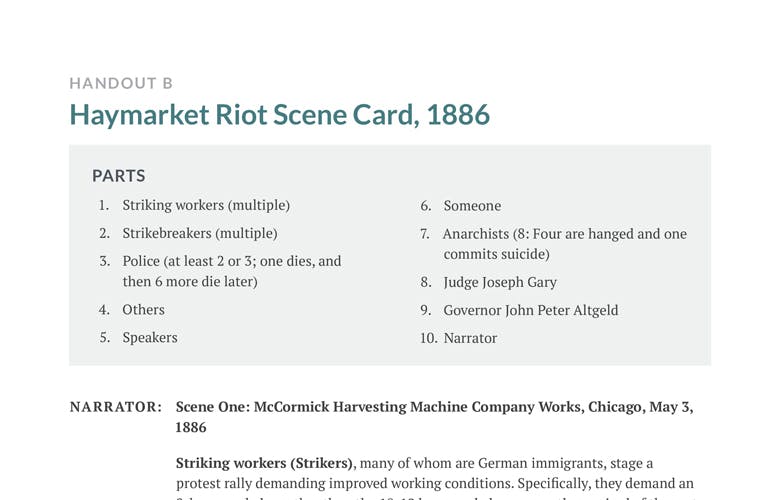Handout B: Haymarket Riot Scene Card 1886
Haymarket Riot Scene Card, 1886
PARTS
- Striking workers (multiple)
- Strikebreakers (multiple)
- Police (at least 2 or 3; one dies, and then 6 more die later)
- Others
- Speakers
- Someone
- Anarchists (8: Four are hanged and one commits suicide)
- Judge Joseph Gary
- Governor John Peter Altgeld
- Narrator
NARRATOR: Scene One: McCormick Harvesting Machine Company Works, Chicago, May 3, 1886
Striking workers (Strikers), many of whom are German immigrants, stage a protest rally demanding improved working conditions. Specifically, they demand an 8-hour work day rather than the 10-12 hour work days currently required of them at McCormick Harvesting Machine Company Works. Strikebreakers, eager to find work during the economic downturn that had already dragged on for several years, are happy to take the jobs that the strikers complain about. Police intimidate the strikers and struggle to keep peace between the two groups. Finally, police insist that the crowd disperse. The disorder continues and police beat some of the demonstrators. Then, the police fire into the crowd to force them to leave the area. One striker is killed and others are injured in the melee.
NARRATOR: Scene Two: Haymarket Square, Chicago, May 4, 1886
Strikers and Others gather at Haymarket Square, an open area used for public markets, in order to protest against police violence. The crowd hears several Speakers who explain their ideas about social and economic reform to protect the rights of workers. Some speakers advocate radical ideas such as socialism and anarchism. The rally is peaceful throughout the day. At the end of the rally, Someone throws a bomb into a group of Policemen, killing one. Other police fire their weapons randomly into the darkness. In the resulting riot, at least four civilians and six more officers are killed. Soon the square is empty except for the casualties. At least some of the officers killed and injured were shot by one another’s service revolvers. In the investigation that followed, there was great sympathy and support for the police. Fueled by a sensationalist press, opinion turned against immigrants, radicals, and the labor movement in general. The investigation following the riot resulted in the arrest of eight Anarchists, most of whom were German immigrants.
NARRATOR: Scene Three: Courtroom of Judge Joseph Gary, June through August, 1886
The trial of the Anarchists included the presentation of some evidence attempting to link shrapnel from the scene to homemade bombs found in the home of one of the defendants. However, Judge Joseph Gary conducted the trial with little concern for due process for the defendants. It was never established who built the bomb, or who threw the bomb. Only two of the defendants were even present in Haymarket Square on the evening of the riot. Most prospective jurors stated before the trial that they had already formed the opinion that the defendants were guilty. In spite of many inconsistencies in the prosecution’s evidence, the judge ruled against the defense attorneys again and again. After only three hours, the jury found seven of the defendants guilty of murder, and recommended that they be executed. The eighth defendant was sentenced to serve fifteen years in prison. Judge Gary’s reasoning was that, whether they were present in Haymarket Square or not, the anarchists were guilty of murder because they had incited the bomb-throwing through their radical speech and writing. In their appeals in state courts and in the U.S. Supreme Court, they claimed that they had been denied due process under the Fourth and Sixth Amendments, but they lost at both levels. In November, 1887, one of the defendants committed suicide and four others were executed by hanging.
NARRATOR: Scene Four: Illinois Governor Altgeld’s Office, 1893
Illinois Governor John Peter Altgeld (a German immigrant himself) pardoned the remaining three defendants, citing the hysteria surrounding the trial, the biased judge, and the lack of physical evidence against the men. Altgeld faced political fallout for the pardons as many newspapers across the U.S. accused him of supporting anarchism.
In the meantime, the Knights of Labor had faded into insignificance for several reasons:
- The Knights’ philosophy that all workers should be included in one massive “brotherhood of labor” resulted in their welcoming all kinds of workers, including many who were immigrants and had unpopular ideas that fed the xenophobia and prejudices of the day.
- The Knights of Labor were blamed for furthering a climate of violence that encouraged the Haymarket tragedy, though they were never directly involved with the strike at McCormick.
- The Knights represented so many different interests and philosophies that they could not agree on goals, leading to problems of leadership.
- Many Americans lost sympathy for the needs of labor unions. Due to the press reports on the incidents, readers tended to associate union activities with dangerous ideas.
- Other strikes led by the Knights of Labor failed.
REVIEW QUESTIONS
- Explain the constitutional principles that are relevant in the events surrounding the Haymarket Riot.
- What social and/or economic problems are evident leading up to the Haymarket Riot?
- What methods to bring about social change are attempted in the events surrounding the Haymarket Riot? Evaluate the chances for success of each of the methods you identify.
- To what extent are First Amendment or other constitutional protections evident in the Haymarket Riot, its causes and its consequences?
